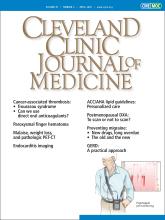ABSTRACT
Fracture is a major cause of morbidity and death in postmenopausal women. Dual-energy x-ray absorptiometry (DXA) measures bone mineral density, which helps in estimating fracture risk and in identifying those who may benefit from treatment. Although screening guidelines differ somewhat for postmenopausal women under age 65, in general, DXA is indicated if the patient has a high risk for fracture.
Footnotes
Dr. Tough DeSapri has disclosed membership on advisory committees or review panels and teaching and speaking for Amgen, and consulting for Radius Health, Inc.
- Copyright © 2020 The Cleveland Clinic Foundation. All Rights Reserved.
- Kristi Tough DeSapri, MD, CCD, NCMP⇑
- Assistant Professor of Obstetrics and Gynecology and Internal Medicine, Feinberg School of Medicine, Northwestern University, Chicago, IL
- ADDRESS:
Kristi Tough DeSapri, MD, CCD, NCMP, Assistant Professor of Ob/GYN and Internal Medicine, Feinberg School of Medicine, Northwestern, 259 East Erie Street, Suite 2450 Chicago, IL 60611; kristi.toughdesapri{at}nm.org
- Rachel Brook, MD
ABSTRACT
Fracture is a major cause of morbidity and death in postmenopausal women. Dual-energy x-ray absorptiometry (DXA) measures bone mineral density, which helps in estimating fracture risk and in identifying those who may benefit from treatment. Although screening guidelines differ somewhat for postmenopausal women under age 65, in general, DXA is indicated if the patient has a high risk for fracture.
Footnotes
Dr. Tough DeSapri has disclosed membership on advisory committees or review panels and teaching and speaking for Amgen, and consulting for Radius Health, Inc.
- Copyright © 2020 The Cleveland Clinic Foundation. All Rights Reserved.









